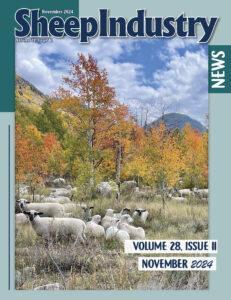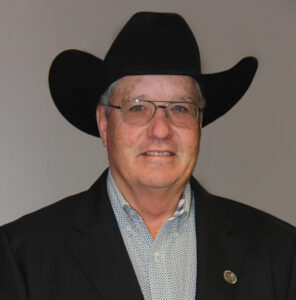In the United States, large swaths of land have been – or are currently being – converted to large-scale solar farms, many acres of which have been obtained from farmers and ranchers. While this is being met with hesitation and concern from much of the agriculture industry – as acres are being taken out of production – the sheep industry has seen benefits.
According to Larry Hopkins, ASI executive board member, past president of the Indiana Sheep Association and ASI solar grazing committee member, there are “roughly 80,000 sheep currently grazing on solar farms across the country right now.”
Solar fields must maintain the vegetation under the solar panels so that it does not become overgrown and end up blocking the sun from hitting the panels. In just one, 13,000-acre solar farm in Indiana alone, there are 4,500 sheep grazing.
Sheep have been very effective in controlling vegetation, as they are small enough to be under the panels, and are non-destructive to the solar fields. This combination of production agriculture and solar fields has been coined agrivoltaics.
According to Energy.gov, agrivoltaics is “defined as agricultural production, such as crop or livestock production or pollinator habitats, underneath solar panels or adjacent to solar panels.”
NAVIGATING AGRIVOLTAICS
When a solar company comes in to build a solar field, it leases the land – typically for 30 years – and pays an annual lease to the landowner, Hopkins explained. The draw to the landowner is “those annual lease payments can be over $1,000 dollars per acre.” Hopkins noted this is significantly more than if you were farming or grazing those same acres.
“The farms that are in a position to take advantage of solar are using it as an additional source of income, and in some cases, it’s a way to preserve the farm and keep it in the family for a generation until a new generation comes along and wants to farm it as opposed to selling it,” Hopkins said.
Jeffrey Allen, instructor at Texas Tech University in the Department of Renewable Energy who also serves as an attorney at Kelly Hart & Hallman, LLP, has been negotiating wind and solar lease agreements for 17 years.
It wasn’t until three or four years ago that Allen began to see developers obtain the right to conduct agrivoltaics-type activities. In fact, he saw the word agrivoltaics for the first time around two months ago in a lease agreement “where it actually had a clause identifying an agrivoltaics right,” he recalled.
“Before that, they didn’t have a word for it. It was just ‘we reserve the right to do this sort of thing,’” Allen said.
Allen explained that solar companies, upon leasing the land, have the sole rights to the surface of the land and even the landowners became limited in what they were able to do with the surface of the land.
Now, agrivoltaics rights – usually either in the form of grazing sheep or setting up a pollinator habitat – are being negotiated along with the other terms of solar lease agreements.
There are benefits to both parties when the land under the solar farm is grazed by sheep, in particular. The landowner is able to “maintain agricultural operations.”
When the land is leased for solar, the solar company takes over the property taxes. In Texas and other states with special use appraisal methods, Allen explained that agrivoltaics is a way to receive an agricultural exemption on the property taxes, reducing the tax burden for the project.
“Historically, up to this point in solar, we’re losing the agricultural exemption because it’s coming out of agricultural and it’s going into an industrial use,” Allen said.
Since agrivoltaics is so new, Allen anticipates some appraisal districts pushing back, but in his opinion, “it is probably in the best interest of the legislature to modify those laws to recognize agrivoltaics” to keep that land as productive as possible.
Despite the benefits, Allen did acknowledge some of the tension between carrying out a grazing lease within a solar farm.
“The solar company is a power plant. It’s an electrical generating facility, and they’re very hesitant to give any third party the keys to the gate and let them in there or come and go without them having direct control over it,” Allen described.
Similarly, the landowner still owns the land and feels the right to access it despite it being leased out.
“So that’s where the push and pull is right now. Most of the language that I’ve seen has been initially granting the right to the solar company to lease the property or operate it themselves,” Allen said.
Representing landowners, Allen said the counter they have presented is allowing the landowner “right of first refusal if the company decides they want to participate in an agrivoltaics operation, they have to first ask the actual landowner if they want to be the ones conducting those operations. That seems like a pretty reasonable compromise.”
SHEEP INDUSTRY BENEFITS
Whether it be the landowner or a third-party sheep producer, Hopkins explained that grazing contracts for sheep are currently one to three years and “the sheep producer will be paid a fee to graze their sheep on that solar farm.”
Hopkins noted that the “grazing contracts usually are more than the going cash rent, so it’s a way for sheep producers to earn extra income beyond what they would get from raising, selling and marketing their sheep.”
Things to keep in mind during negotiations of grazing contracts are the infrastructure needed for the sheep; access to water; how long sheep need to be on the property and how and when they can be taken off; paddocks for rotational grazing; etc, Hopkins noted.
Other things that could be negotiated at the onset of solar projects are retaining topsoil and the type of grass that will be planted below the solar panels. Ideal blends of grass or flowers could be negotiated and agreed upon for both sheep grazing and pollinator agrivoltaics.
“It’s an evolving industry right now. Sheep producers are becoming more aware of these opportunities and learning by trial and error what they need to do to be successful,” Hopkins explained.
With the new opportunity presented by solar fields to the sheep industry, the American Solar Grazing Association has been established with more than 900 members across 45 states already. Hopkins said that in the last two years ASGA has held a “solar farm summit” to bring together solar developers and farmers alike.
“From the sheep industry perspective, the advent of solar grazing for sheep producers is kind of a disruptive force that’s coming to the marketplace. I think it has the potential to really benefit the sheep industry over the long-haul, potentially bringing new producers into the fold,” Hopkins concluded.



